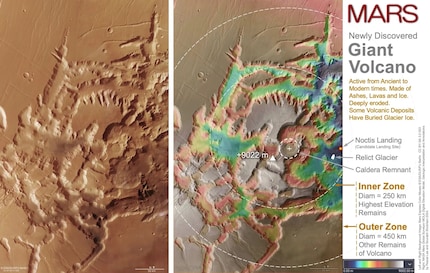
Giant volcano detected on Mars?
A huge volcano may have been discovered in the Valles Marineris area on Mars, which had previously been overlooked. If this is confirmed, it would be up to nine kilometres high and around 450 kilometres wide.
Is there a huge volcano on Mars with a height of nine kilometres and a base width of 450 kilometres that has been overlooked until now? Researchers Pascal Lee and Sourabh Shubham from the SETI Institute in California and the University of Maryland are convinced of this. The suspected volcano is located in the area of the gigantic Valles Marineris, which extend more than 6000 kilometres south of the Martian equator. The exact location is in the eastern part of Noctis Labyrinthus, the "Labyrinth of the Night". These structures were already recorded by the first Mars orbiter Mariner 9 in 1971, when it carried out the first complete mapping of the Red Planet. The huge valley was subsequently named after the space probe. The structure is currently referred to as the "Noctis volcano" as it has not yet been officially recognised and is awaiting confirmation through further investigations.
But how could such a volcanic giant have been overlooked for more than 50 years? Even though Mars is better mapped than Earth? This is because Noctis Labyrinthus is an extremely rugged region of huge valleys that overlap like a network. They were formed as a result of tectonic movements, which lifted and stretched the Martian crust by forces from the Martian interior until it finally cracked. The stretching caused parts of the crust to sink downwards by several kilometres, forming the long, wide valleys. As a result, the shape of the mighty shield volcano is literally dissolved to the eye and is barely recognisable.

Source: © Left: Mars Express HRSC color mosaic © ESA/DLR/FU Berlin CC BY-SA 3.0 IGO; Right: Background image: same as Left; NASA MGS MOLA digital elevation model. Geologic interpretation and annotations by Pascal Lee and Sourabh Shubham 2024) / (https://www.seti.org/press-release/giant-volcano-discovered-mars) (Ausschnitt)
Only when you turn to three-dimensional views and topographical data can you get an idea of the possible volcano. Its highest elevation is 9022 metres above the defined zero level of Mars, but it is located within the so-called Tharsis bulge, a huge region with a diameter of more than 3000 kilometres, which also rises several kilometres above zero level.
The central region of the Noctis volcano consists of several elevated table mountains, so-called mesas, which form an arc and create a regional elevation. From here, the gently sloping slopes extend to a distance of 225 kilometres. There is also a crater structure there, the topography of which corresponds to a caldera, a volcanic collapse crater. Furthermore, the two authors discovered solidified lava flows, pyroclastic deposits (these consist of volcanic particles and loose masses such as ash, cinders and pumice) as well as hydrated minerals that have changed chemically due to the influence of water in the area in question on images from several space probes, including the ESA Mars Express probe.
In addition, there is a crater structure with the topography of a caldera, a volcanic collapse crater.
There is also evidence that the Noctis volcano was active over a long period of time; its last eruptions probably occurred in the Red Planet's modern geological period. This is indicated by dark, solidified lava flows that have not yet been completely covered by the omnipresent reddish Martian dust. Further investigations must now show whether the suspected Noctis volcano can be definitively confirmed. In any case, Noctis Labyrinthus is a highly interesting area from a geological, or rather areological, point of view.
Spectrum of Science
We are partners of Spektrum der Wissenschaft and would like to make well-founded information more accessible to you. Follow Spektrum der Wissenschaft if you like the articles
Originalartikel auf Spektrum.de
Titelbild: © NASA/USGS (Ausschnitt) Das riesige Talsystem Valles Marineris erstreckt sich über mehr als 6000 Kilometer südlich des Marsäquators. Das Noctis Labyrinthus ist nahe dem linken Rand der Planetenkugel sichtbar.
Experts from science and research report on the latest findings in their fields – competent, authentic and comprehensible.
From the latest iPhone to the return of 80s fashion. The editorial team will help you make sense of it all.
Show all